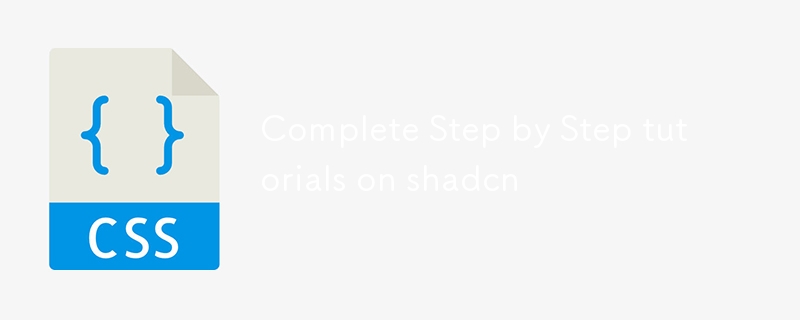
您是否厌倦了花费无数时间从头开始制作漂亮的用户界面? ?别再犹豫了! Shadcn 是一个强大的 UI 组件库,它将彻底改变您的 Web 开发过程。无论您是经验丰富的开发人员还是刚刚起步的开发人员,Shadcn 都提供了一个预构建组件的宝库,可以将您的项目提升到一个新的水平。
但是你从哪里开始呢? ? UI 库的世界可能让人不知所措,而深入研究一个新的库似乎令人畏惧。这就是我们创建 Shadcn 综合指南的原因。从安装到先进技术,我们将引导您完成整个旅程的每一步。在本教程结束时,您将轻松制作令人惊叹的界面,给客户和用户留下深刻的印象。
准备好释放 Shadcn 的全部潜力了吗?让我们一起踏上这段激动人心的旅程吧!我们将从了解 Shadcn 的全部内容开始,然后继续介绍安装、核心组件、先进技术,最后将它们整合到实际项目中。系好安全带——您的 UI 掌握之路现在开始! ??
Shadcn 是一个尖端的 UI 组件库,因其灵活性和易用性而受到开发人员的青睐。 Shadcn 构建在 React 之上,提供了一系列设计精美、可访问且可自定义的组件,可以显着简化构建现代 Web 应用程序的过程。
Shadcn 的主要优势包括:
要开始使用 Shadcn,您需要设置开发环境。这是分步指南:
Shadcn 具有多种功能,使其从其他 UI 库中脱颖而出:
| 功能 | 描述 |
|---|---|
| 组件库 | 一套全面的预构建、可定制的 UI 组件 |
| 主题 | 强大的主题功能,可在您的应用程序中实现一致的设计 |
| 响应式设计 | 无缝适应不同屏幕尺寸的组件 |
| 深色模式支持 | 内置支持深色模式,提升用户体验 |
| TypeScript 支持 | 完整的 TypeScript 支持,可提高类型安全性和开发人员生产力 |
Some of the core components offered by Shadcn include:
These components serve as building blocks for creating complex user interfaces, allowing developers to focus on application logic rather than reinventing the wheel for common UI elements.
By leveraging Shadcn's powerful features and comprehensive component library, developers can significantly reduce development time while maintaining high-quality, accessible, and visually appealing user interfaces. As we move forward, we'll explore how to install and set up Shadcn in your project, providing you with the foundation to start building amazing web applications.
Now that we've explored what Shadcn is and its capabilities as a powerful UI component library, let's dive into the practical aspects of getting started with Shadcn installation. This section will guide you through the process of setting up Shadcn in your project and using your first component.
To begin your journey with Shadcn, you'll need to install it in your project. You can do this using either npm or yarn, depending on your preference. Here's how to install Shadcn:
Using npm:
npm install @shadcn/ui
Using yarn:
yarn add @shadcn/ui
Once the installation is complete, you're ready to start configuring Shadcn in your project.
After installing Shadcn, you'll need to configure it in your project. This involves setting up the necessary files and dependencies. Here's a step-by-step guide
module.exports = { darkMode: ["class"], content: [ './pages/**/*.{ts,tsx}', './components/**/*.{ts,tsx}', './app/**/*.{ts,tsx}', './src/**/*.{ts,tsx}', ], theme: { extend: {}, }, plugins: [require("tailwindcss-animate")], }
Create a globals.css file in your styles directory and add the following:
@tailwind base; @tailwind components; @tailwind utilities;
Import the globals.css file in your main application file (e.g., _app.tsx for Next.js).
Now that Shadcn is installed and configured, let's import and use your first component. We'll use the Button component as an example:
Import the Button component in your desired file:
import { Button } from "@shadcn/ui/button"
Use the Button component in your JSX:
Here's a comparison of some common Button variants you can use:
| Variant | Description | Use Case |
|---|---|---|
| default | Standard button | General purpose |
| outline | Button with outline | Secondary actions |
| ghost | Transparent button | Subtle actions |
| link | Button that looks like a link | Navigation within tex |
By following these steps, you've successfully installed Shadcn, configured it in your project, and used your first component. This sets the foundation for exploring more of Shadcn's core components and building more complex UI elements in your project.
Next, we'll delve deeper into Shadcn's core components, examining their features and how to customize them to fit your specific needs.
Now that we've covered the installation process, let's dive into the heart of Shadcn by exploring its core components. These building blocks are essential for creating stunning and functional user interfaces.
Shadcn provides intuitive navigation components that enhance user experience. The menu and dropdown components are particularly useful for creating organized and interactive navigation systems.
Here's an example of a simple dropdown implementation:
Open Option 1 Option 2 Option 3
Modals and dialogs are crucial for displaying important information or gathering user input without navigating away from the current page. Shadcn offers a robust set of modal and dialog components that are both customizable and accessible.
To implement a basic modal, use the following code structure:
The button component in Shadcn is highly versatile and can be customized to fit various design needs. It comes with several pre-defined variants and allows for easy customization.
Button variants include:
To use a button with a specific variant, simply add the variant prop:
Customizing buttons is straightforward with Shadcn's theming system. You can modify colors, sizes, and other properties to match your design requirements.
With these core components at your disposal, you're well-equipped to start building sophisticated user interfaces. In the next section, we'll explore advanced Shadcn techniques to take your development skills to the next level.
Now that we've covered the core components of Shadcn, let's dive into some advanced techniques that will take your Shadcn skills to the next level.
Optimizing your Shadcn components can significantly improve your application's performance. Here are some key strategies:
Shadcn seamlessly integrates with various popular frameworks, enhancing your development experience. Here's how you can integrate Shadcn with some common frameworks:
One of Shadcn's strengths is its flexibility in creating custom components. Follow these steps to create your own:
Shadcn offers a powerful theming system that allows you to customize the look and feel of your components. Here's how to make the most of it:
// Example of a custom theme object const customTheme = { colors: { primary: '#3498db', secondary: '#2ecc71', background: '#ecf0f1', }, fonts: { body: 'Roboto, sans-serif', heading: 'Montserrat, sans-serif', }, // ... other theme properties };
By mastering these advanced Shadcn techniques, you'll be able to create more efficient, customizable, and visually appealing applications. Next, we'll explore how to apply these skills in real-world projects, putting theory into practice.
Shadcn 为希望创建令人惊叹且功能齐全的用户界面的开发人员提供了全面的解决方案。从简单的安装过程到广泛的核心组件和先进技术,这个强大的 UI 库提供了使 Web 应用程序栩栩如生所需的一切。
通过遵循本指南中概述的分步教程,您可以快速掌握 Shadcn 并开始构建令人印象深刻的实际项目。无论您是初学者还是经验丰富的开发人员,Shadcn 的多功能性和强大功能都使其成为您 Web 开发库中的宝贵工具。拥抱 Shadcn 的力量,将您的 UI 设计技能提升到新的高度。
以上是在 shadcn 上完成分步教程的详细内容。更多信息请关注PHP中文网其他相关文章!




